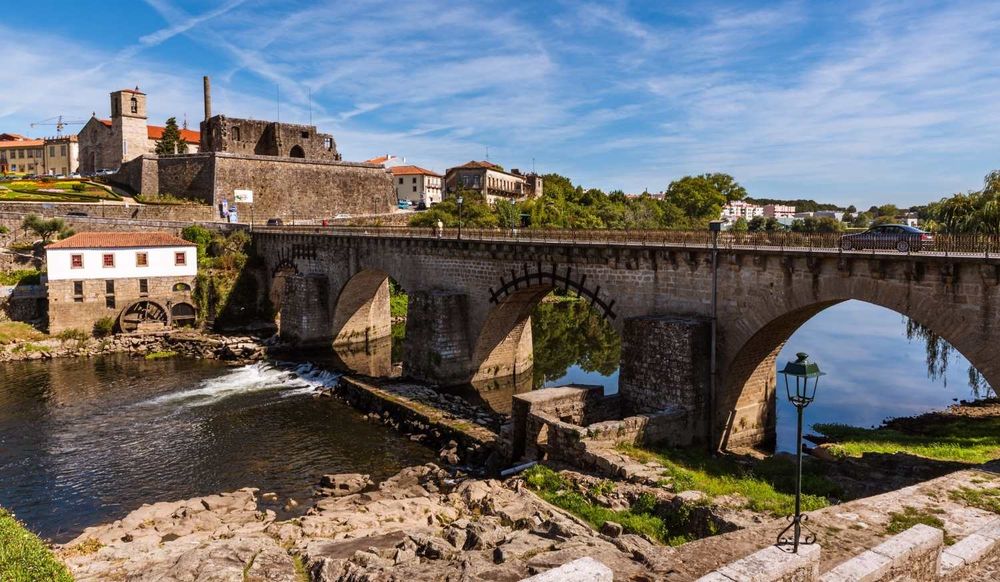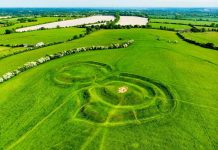The natural beauty of Portugal’s oldest region forms the backdrop for this proud and traditional land.
Porto
(Classified by UNESCO World Heritage site) The North’s most important city lent its name to the famous wine and to Portugal. One must stroll around its typical quarters (especially the area on the waterside, the ‘zona ribeirinha’) and its bustling downtown. Visit: the Stock Exchange Palace, the Romanesque-Gothic Cathedral, the church of Cedofeita (Romanesque), the Clérigos tower (Porto’s ex-libris of Baroque architecture) and church; the church of São Francisco, of Romanesque origin, with its interior covered in gilded carvings, and the church of Carmo, with tiled façades. Museums: Soares dos Reis, Casa de Serralves (modern art), Casa-Museu de Guerra Junqueiro and the Romantic Style Museum of Quinta da Macieirinha. One should not miss a visit to the Port lodges in Vila Nova de Gaia and free tasting of the famous port wine.
The Douro region
The Douro river is the longest in northern Portugal. It winds its sinuous way past mountains and cliffs until it reaches the Atlantic near the city of Porto.
Many dams have been built to make the river navigable, which for the visitor means that plenty of pleasure and cruise boats depart from Porto to the Douro region. Between Mesão Frio and Pinhão lies the stretch where the valley sides are lined with terraced vineyards that produce the famous Port wine. But this region is famous for other things besides the wine that is made nowhere else in the world. Signs of prehistoric men are seen in the ancient cave paintings in Vila Nova de Foz Côa. Elsewhere, medieval castles and convents or Romanesque little churches dot the landscape. History, too, is evoked by the manor houses, such as the Baroque mansion at Mateus, near Vila Real, or in the great 17th century sanctuaries, such as Nossa Senhora dos Remédios in Lamego, which plays such an important role in people’s devotions.
North East Region of Trás-os-Montes
In this region people keep alive traditions of dance and song (showing strong Celtic influence, as in the Pauliteiros dance at the village of Miranda) and in their secular festivals and processions, which reveals how Christian rituals were grafted onto a much older pagan heritage.
A paradise of unspoiled natural resources, the region is a perfect place for mountain trekking, canoeing or simply resting up in the spa towns of Carvalhelhos, Chaves, and Pedras Salgadas. Vidago has a magnificent park with swimming pools and a golf course.
The Coastal Region of Minho
Porto is without doubt the main city in northern Portugal. It has an international airport and all the charms of a riverside community. It also keeps alive traditional values while pushing ahead with a dynamic, innovative spirit in its commercial and industrial life.
Along the coastline north of Porto runs a coastal road linking Vila do Conde to Valença. It takes visitors past beautiful beaches, summer resorts and enchanting villages, such as Caminha and Vila Nova de Cerveira. Inland, one must visit the huge national park area covering the mountains of Peneda, Soajo and Gerês.
Three towns that set the tone for this charming area of Portugal are Viana do Castelo, lying upon the estuary of the Lima river; Braga, rich in ecclesiastical history; and the medieval Guimarães. Mansions and manorial houses in this region open their doors to bed and breakfast, offering visitors a rare privileged glimpse of aristocratic Portuguese traditions, combined with the best modern hospitality can offer.
Places of interest
Barcelos
Medieval walled town and a dungeon of the same epoch. Worthy of a visit are the Ceramics Museum (Museu de Olaria), the Archeologic Museum of the Dukes’ Palace, the mother-church (Romanesque-Gothic), and the churches of Terço, Cruzes and Benedictine Convent. Walking tours around the ancient Jewish quarter or in the streets with medieval houses and Baroque manors; boat tours on the Cávado river.
Braga
Founded by the Celts in 300 B.C. and a Roman administrative centre in 27 B.C., Bracara Augusta, as the Romans named it, combines the religious importance with today’s commercial and industrial prosperity. To visit: the Cathedral (12th-18th centuries), the treasury and Sacred Art Museum; the museum at the Biscainhos Palace; and the Dom Diogo de Sousa Museum. Also deserving to be visited are the churches of Misericórdia (Renaissance), Pópulo (17th-18th centuries) and of Nossa Senhora Branca (18th century). On the outskirts, 2.5 miles away from the centre, stands the sanctuary of Nossa Senhora do Sameiro; the ancient monastery of Tibães, dating back to the Suevian period and rebuilt in the 11th century, and the Church of São Frutuoso de Montélios (a 7th-century Visigothic temple).
Bragança
Majestic city, with medieval castle and walls. Its Domus Municipalis is a unique example of civic Romanesque architecture in Portugal. Special mention must be made to the Cathedral (16th century), Santa Maria Church, Casa da Misericórdia Chapel, Santa Clara Convent and Church (16th century), São Bento Convent and Church (17th-18th centuries), and the Abade de Baçal Museum. At the Railway Museum, 19th century, locomotives and carriages.
Chaves
Crossing the Tâmega river, the Roman bridge is one of the most characteristic images of the city. The 14th century castle houses the Archeology and Epigraphy Museum. The forts of São Francisco and São Neutel (18th century), the mother-church (Romanesque origin), and the Misericórdia Church (Baroque) are worthy of a visit. Notice the original balconies of the houses in Rua Direita.
Guimarães
Portugal’s birthplace, with medieval castle and walls, houses a magnificently well-preserved historic centre. In the cloisters of the church of Nossa Senhora da Oliveira is the Alberto Sampaio Museum; and the cloister of São Domingos Convent houses the Martins Sarmento Museum. In the ancient dominican convent stands the Sacred Art Museum. Also deserving special mentions are the palace of the Dukes of Bragança (15th-century), the church of São Miguel (Romanesque), the church of Santos Passos (Baroque), and the monastery of Santa Marinha da Costa (converted in to a pousada). Nearby lies the early settlement of Briteiros.
Lamego
From the heart of a verdant park rises the sanctuary of Nossa Senhora dos Remédios, with its magnificent Baroque staircase (686 steps). Medieval monuments: (castle, tower-fortress 12th-13th centuries) and the Almacave Church. Also worthwhile visiting are the Renaissance churches of Chagas and Santa Cruz, and the Regional Museum and at the village of Balsemão, the chapel of Suevian-Byzantine origin (7th century).
Ponte de Lima
Beautiful small town with a Roman bridge and medieval towers. The region is renowned for its large number of manor houses (accommodation provided in privately-owned manor houses).
Viana do Castelo
Spread along the north bank of the Lima estuary (where one can take trips on typical boats), this town is famous for its handicrafts and colorful regional costumes. Deserving special mention are the mother-church and the ancient Paços do Concelho (both Gothic), Casa da Misericórdia (Mannerist, with a sacred art treasure), the medieval Casa dos Arcos, the convent of Santa Ana (16th-century), and the Regional Museum. Up above and dominating the city is the sanctuary of Santa Luzia, featuring a fantastic view of the town, the river and the Atlantic ocean.
Vila do Conde
Ancient medieval shipyard. Interesting architectonic places to visit are the mother-church (Manueline style), the Santa Clara Convent (18th century), the Misericórdia Church (Renaissance), the Aqueduct, and St. John the Baptist Fortress. This town is also famous for its manufactured lace.
Vila Nova de Foz Côa
This is the center for visits to the Côa Archaeological Park, and where a set of cave paintings were discovered on the banks the river Côa dating from the upper Paleolithic period. From here visits can be arranged to the centers of Penascosa, Ribeira de Priscos and Canada do Inferno. In Vila Nova de Foz Côa itself the main church contains a beautiful portico from the Manueline period.
Vila Real
Town with great religious architecture diversity: Cathedral and São Brás Chapel (Gothic); churches of São Pedro and Misericórdia (16th century), São Dinis (16th-18th centuries) and the Baroque Capela Nova and Clérigos Church. Also worthwhile visiting nearby the city is the famous Mateus Palace, a Baroque masterpiece, where cultural events are currently held.
Other places of interest
Amarante, Arcos de Valdevez, Azurara, Cabeceiras de Basto, Caldas das Taipas and Caldelas (spas), Caminha, Carrazedo, Espinho (casino), Esposende, Fão, Freixo de Espada à Cinta, Gondomar, Marco de Canaveses, Melgaço, Mesão Frio, Miranda do Douro, Mirandela, Monção, Montalegre, Murça, Paços de Ferreira, Penafiel, Peso da Régua, Ponte da Barca, Póvoa de Varzim (casino), Ribeira de Pena, Santa Maria de Bouro, Santo Tirso, S. João de Tarouca (Cister monastery, 12th century), Sernancelhe, Valença, Vieira do Minho, Vila Flor, Vila Nova de Cerveira, Vila Nova de Gaia, Vilar de Frades, Vizela.
Local gastronomy
- Caldo verde (cale and spicy sausage soup)
- Bacalhau (dried salt cod fish)
- Feijoada à transmontana (bean stew)
- Trout
- Rabanadas, papos-de-anjo, barrigas-de-freiras (sweetmeats)
- Wines: vinhos verdes, Port wine, wines from the Douro region and Trás-os-Montes
Handicafts
- Embroideries, linen, textiles and tapestry
- Jewelry and filigree
- Popular ceramics and pottery
- Works in wood, leather, copper, tin, wrought iron, wicker and osier.

























